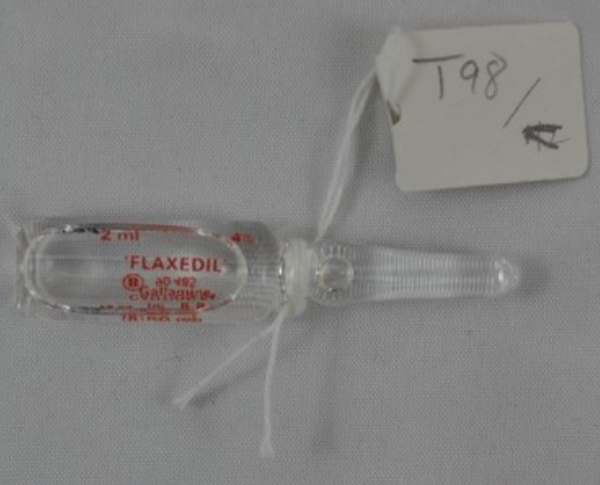Gallamine Triethiodide on:
[Wikipedia]
[Google]
[Amazon]
 Gallamine triethiodide (Flaxedil) is a
Gallamine triethiodide (Flaxedil) is a
Presence of
 Gallamine triethiodide (Flaxedil) is a
Gallamine triethiodide (Flaxedil) is a non-depolarising muscle relaxant
Neuromuscular-blocking drugs, or Neuromuscular blocking agents (NMBAs), block transmission at the neuromuscular junction, causing paralysis of the affected skeletal muscles. This is accomplished via their action on the post-synaptic acetylcho ...
. It acts by combining with the cholinergic receptor
An acetylcholine receptor (abbreviated AChR) or a cholinergic receptor is an integral membrane protein that responds to the binding of acetylcholine, a neurotransmitter.
Classification
Like other transmembrane receptors, acetylcholine receptors ...
sites in muscle
Muscle is a soft tissue, one of the four basic types of animal tissue. There are three types of muscle tissue in vertebrates: skeletal muscle, cardiac muscle, and smooth muscle. Muscle tissue gives skeletal muscles the ability to muscle contra ...
and competitively blocking the transmitter action of acetylcholine
Acetylcholine (ACh) is an organic compound that functions in the brain and body of many types of animals (including humans) as a neurotransmitter. Its name is derived from its chemical structure: it is an ester of acetic acid and choline. Par ...
. Gallamine is a non-depolarising type of blocker as it binds to the acetylcholine receptor but does not have the biological activity
In pharmacology, biological activity or pharmacological activity describes the beneficial or adverse effects of a drug on living matter. When a drug is a complex chemical mixture, this activity is exerted by the substance's active ingredient or ...
of acetyl choline. Gallamine triethiodide has a parasympatholytic
A parasympatholytic agent is a substance or activity that reduces the activity of the parasympathetic nervous system.
The term parasympatholytic typically refers to the effect of a drug, although some poisons act to block the parasympathetic n ...
effect on the cardiac vagus nerve
The vagus nerve, also known as the tenth cranial nerve (CN X), plays a crucial role in the autonomic nervous system, which is responsible for regulating involuntary functions within the human body. This nerve carries both sensory and motor fibe ...
, which causes tachycardia
Tachycardia, also called tachyarrhythmia, is a heart rate that exceeds the normal resting rate. In general, a resting heart rate over 100 beats per minute is accepted as tachycardia in adults. Heart rates above the resting rate may be normal ...
and occasionally hypertension
Hypertension, also known as high blood pressure, is a Chronic condition, long-term Disease, medical condition in which the blood pressure in the artery, arteries is persistently elevated. High blood pressure usually does not cause symptoms i ...
. Very high doses cause histamine
Histamine is an organic nitrogenous compound involved in local immune responses communication, as well as regulating physiological functions in the gut and acting as a neurotransmitter for the brain, spinal cord, and uterus. Discovered in 19 ...
release.Presence of
iodine
Iodine is a chemical element; it has symbol I and atomic number 53. The heaviest of the stable halogens, it exists at standard conditions as a semi-lustrous, non-metallic solid that melts to form a deep violet liquid at , and boils to a vi ...
makes it radio opaque
Radiodensity (or radiopacity) is opacity to the radio wave and X-ray portion of the electromagnetic spectrum: that is, the relative inability of those kinds of electromagnetic radiation to pass through a particular material. Radiolucency or hypode ...
, and its ampule
An ampoule (also ampul and ampule) is a small sealed vial which is used to contain and preserve a sample, usually a solid or liquid. Ampoules are usually made of glass.
Modern ampoules are most commonly used to contain pharmaceuticals and che ...
in a bag at airport's x-ray scanner
An X-ray (also known in many languages as Röntgen radiation) is a form of high-energy electromagnetic radiation with a wavelength shorter than those of ultraviolet rays and longer than those of gamma rays. Roughly, X-rays have a wavelength ran ...
raise the false suspicion of a bullet
A bullet is a kinetic projectile, a component of firearm ammunition that is shot from a gun barrel. They are made of a variety of materials, such as copper, lead, steel, polymer, rubber and even wax; and are made in various shapes and constru ...
in the bag.
Gallamine triethiodide was commonly used to prevent muscle contractions during surgical procedures, but is now superseded by new neuromuscular blocking drugs
Neuromuscular-blocking drugs, or Neuromuscular blocking agents (NMBAs), block transmission at the neuromuscular junction, causing paralysis of the affected skeletal muscles. This is accomplished via their action on the post-synaptic acetylcho ...
with less side effects
In medicine, a side effect is an effect of the use of a medicinal drug or other treatment, usually adverse but sometimes beneficial, that is unintended. Herbal and traditional medicines also have side effects.
A drug or procedure usually used ...
.
It was developed by Daniel Bovet
Daniel Bovet (23 March 1907 – 8 April 1992) was a Swiss-born Italian pharmacologist who won the 1957 Nobel Prize in Physiology or Medicine for his discovery of drugs that block the actions of specific neurotransmitters. He is best known for hi ...
in 1947.
The drug is no longer marketed in the United States, according to the FDA Orange Book.
See also
*Neuromuscular-blocking drug
Neuromuscular-blocking drugs, or Neuromuscular blocking agents (NMBAs), block transmission at the neuromuscular junction, causing paralysis of the affected skeletal muscles. This is accomplished via their action on the post-synaptic acetylcho ...
* Curare
Curare ( or ; or ) is a common name for various alkaloid arrow poisons originating from plant extracts. Used as a paralyzing agent by indigenous peoples in Central and South America for hunting and for therapeutic purposes, curare only ...
References
{{Muscarinic acetylcholine receptor modulators M2 receptor antagonists Muscle relaxants Neuromuscular blockers Nicotinic antagonists Phenol ethers Quaternary ammonium compounds